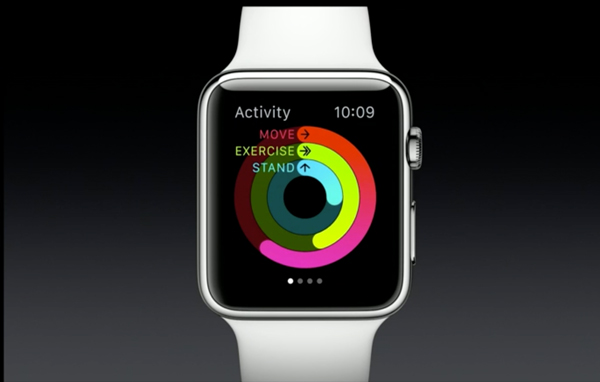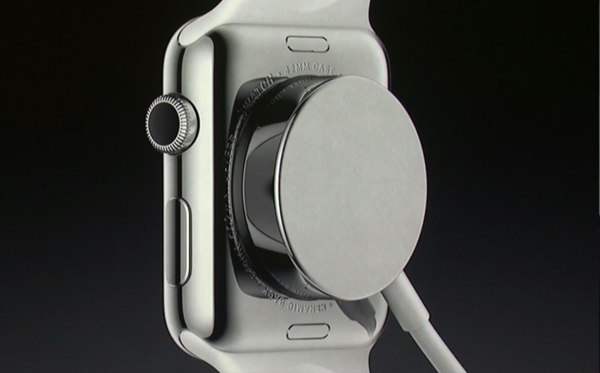Apple Watch Battery Life: How It Measures Up
Apple says you can go 18 hours before you'll need to charge your Apple Watch. That's unlikely to make other smartwatch makers envious.

When you've just paid at least $349 for a fancy new smartwatch, the last thing you want is to run out of time. So while issues like pricing and apps have been much on the mind of would-be Apple Watch users, one of the biggest questions about Apple's new smartwatch is also one of the most basic: Just how long will this thing last before the battery gives out?
MORE: Best Smartwatch - Top-Rated Watches - Tom's Guide
Apple provided an answer at its Apple Watch press event today (March 9): close to a full day. While that's likely to satisfy some users, it's not a stat likely to send other smartwatch makers scurrying back to the drawing board.
Specifically, Apple said the Apple Watch can offer all-day battery life of up to 18 hours. Apple's basing that figure on testing using a pre-production Apple Watch paired to an iPhone with early versions of the software. In getting 18 hours of battery life, Apple tallied 90 time checks, 90 notifications, 45 minutes of apps use, and a 30-minute workout playing back music over Bluetooth.
Whether that will translate to real-world use will have to wait until the Apple Watch arrives in nine countries on April 24. From this vantage point, Apple's test seems to suggest moderate use of the watch, and even Apple acknowledges that different uses and configurations can skew the battery numbers one way or the other.
Dig into the numbers on Apple's battery testing page, and you can get even more of a sense of how the Apple Watch will perform under certain conditions. A talk time test using the Apple Watch to receive phone calls yielded 3 hours of battery life, while Apple lists 6.5 hours for audio playback. A workout session in which the Apple Watch's heart rate sensor was on produced 7 hours of battery life. And if you just use your smartwatch as a watch, you can expect it to keep on ticking for up to 48 hours, assuming you limit yourself to five time checks per hour.
The Apple Watch features a power reserve mode that kicks in automatically when your battery gets too low. This enables your watch to keep displaying the time even if you don't have enough juice to access other features. Apple says power reserve mode can keep the watch features running for up to 72 hours, assuming four time checks per hour.
How Apple Watch Battery Life Measures Up
Apple's promise of an 18-hour battery life lags behind the listed battery times for other smartwatches, though it's worth remembering that real-world use doesn't always match what device makers promise. Watches running Android Wear, for example, typically promise up to two days of battery life, but our testing found that Moto 360 needs charging each day. Our tests found that both the Samsung Gear 2 and the LG G Watch R came closer to that two-day promise -- even more so in the G Watch R's case, if you turn the watch off at night when you go to bed.
Of course, Pebble's smartwatch remains the reigning king of battery life, lasting between 5 and 7 days on a charge, though it's not a perfect comparison since the Pebble sports a less power-demanding ePaper display. Even so, the upcoming Pebble Time smartwatch and its color ePaper display promise to keep that runtime intact.

Apple seems to be betting that the capabilities and design of its watch will make up for having to charge the device at the end of each day, especially in a world where smartphone users are already conditioned to plug in their phones whenever they're not out and about. When it is time to charge the Apple Watch, Apple wants to make sure the process is as simple as possible; it's made a magnetic charger that clicks into place on the back of the watch so that you can power up for another day.
- Apple Watch: Top 10 Features
- Apple Watch FAQ: Everything You Need to Know
- Why Apple's iWatch Already Beats Android Wear
Sign up to get the BEST of Tom's Guide direct to your inbox.
Get instant access to breaking news, the hottest reviews, great deals and helpful tips.
Philip Michaels is a Managing Editor at Tom's Guide. He's been covering personal technology since 1999 and was in the building when Steve Jobs showed off the iPhone for the first time. He's been evaluating smartphones since that first iPhone debuted in 2007, and he's been following phone carriers and smartphone plans since 2015. He has strong opinions about Apple, the Oakland Athletics, old movies and proper butchery techniques. Follow him at @PhilipMichaels.
-
Kafantaris The Apple Watch lacks real life utility and this makes it a gadget in search of a purpose. And the proposed price structure threatens to make Apple's watch a status symbol and thus separate the haves from the have nots. No company built on mass appeal should ever go down that path.Reply

